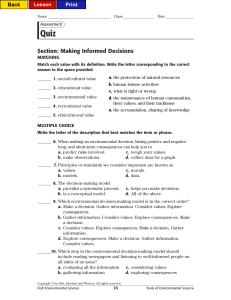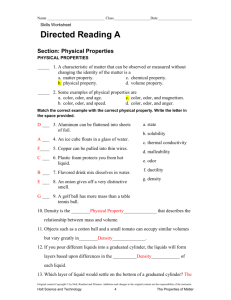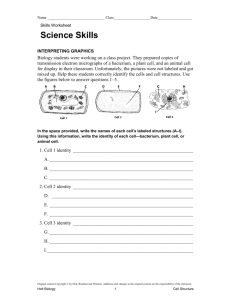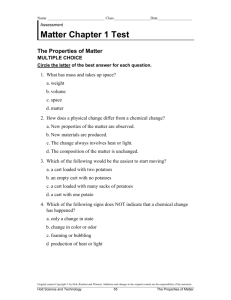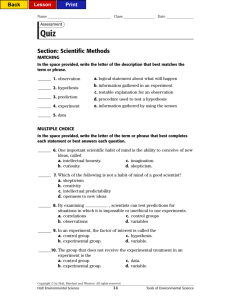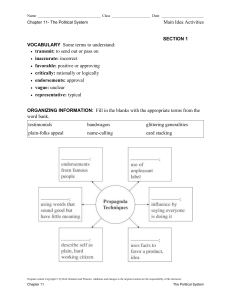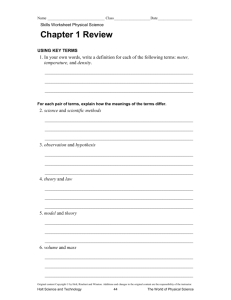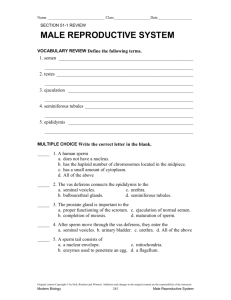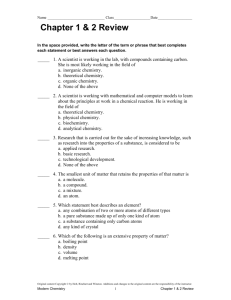Document
advertisement
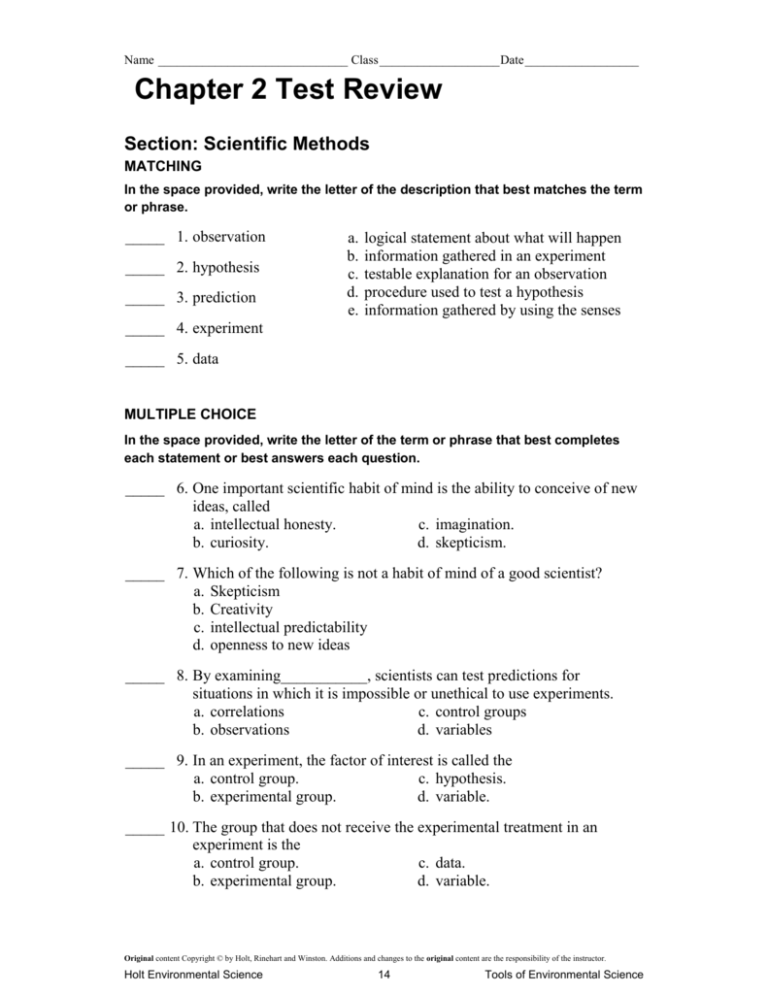
Name ______________________________ Class ___________________ Date __________________ Chapter 2 Test Review Section: Scientific Methods MATCHING In the space provided, write the letter of the description that best matches the term or phrase. _____ 1. observation _____ 2. hypothesis _____ 3. prediction a. b. c. d. e. logical statement about what will happen information gathered in an experiment testable explanation for an observation procedure used to test a hypothesis information gathered by using the senses _____ 4. experiment _____ 5. data MULTIPLE CHOICE In the space provided, write the letter of the term or phrase that best completes each statement or best answers each question. _____ 6. One important scientific habit of mind is the ability to conceive of new ideas, called a. intellectual honesty. c. imagination. b. curiosity. d. skepticism. _____ 7. Which of the following is not a habit of mind of a good scientist? a. Skepticism b. Creativity c. intellectual predictability d. openness to new ideas _____ 8. By examining___________, scientists can test predictions for situations in which it is impossible or unethical to use experiments. a. correlations c. control groups b. observations d. variables _____ 9. In an experiment, the factor of interest is called the a. control group. c. hypothesis. b. experimental group. d. variable. _____ 10. The group that does not receive the experimental treatment in an experiment is the a. control group. c. data. b. experimental group. d. variable. Original content Copyright © by Holt, Rinehart and Winston. Additions and changes to the original content are the responsibility of the instructor. Holt Environmental Science 14 Tools of Environmental Science Name ______________________________ Class ___________________ Date __________________ Section 2: Statistics and Models MATCHING In the space provided, write the letter of the description that best matches theterm or phrase. _____ 1. physical model _____ 2. graphical model _____ 3. mathematical model _____ 4. conceptual model a. a flow chart b. includes maps and charts c. three-dimensional representation you cantouch d. equation representing how a process works MULTIPLE CHOICE Choose the best response. Write the letter of that choice in the space provided. _____ 5. Scientists use statistics to a. graph data. b. analyze data. c.communicate ideas to each other. d. All of the above _____ 6. To get an accurate result, a sample size must be a. small enough to give an accurate estimate for two or more populations. b. large enough to give an accurate estimate for a whole population. c. equal to the mean. d. greater than the mean. _____ 7. When studying a system, a conceptual model can help scientists understand a. what components a system contains. b. how the system components affect each other. c. Both (a) and (b) d. None of the above _____ 8. Which model is particularly useful in scientific cases with many variables? a. physical c. conceptual b. graphical d. mathematical _____ 9. Risk is a. the collection of numerical data. b. the probability that something wanted will happen. c. the probability that something unwanted will happen. d. a group of similar things of interest to a scientist. _____ 10. The classification and collection of data that are in the form of numbers is called a. statistics. c. distribution. b. probability. d. mean. Original content Copyright © by Holt, Rinehart and Winston. Additions and changes to the original content are the responsibility of the instructor. Holt Environmental Science 94 Tools of Environmental Science Name ______________________________ Class ___________________ Date __________________ Section 3: Making Informed Decisions MATCHING Match each value with its definition. Write the letter corresponding to the correct answer in the space provided. a. the protection of natural resources b. human leisure activities c. what is right or wrong d. the maintenance of human communities, their values, and their traditions e. the accumulation, sharing of knowledge _____ 1. social/cultural value _____ 2. educational value _____ 3. environmental value _____ 4. recreational value _____ 5. ethical/moral value MULTIPLE CHOICE Write the letter of the description that best matches the term or phrase. _____ 6. When making an environmental decision, listing positive and negative long- and short-term consequences can help you to a. predict risks involved. c. weigh your values. b. make observations. d. collect data for a graph. _____ 7. Principles or standards we consider important are known as a. values. c. morals. b. models. d. data. _____ 8. The decision-making model a. provides a systematic process. b. is a conceptual model. c. helps you make decisions. d. All of the above _____ 9. Which environmental decision-making model is in the correct order? a. Make a decision. Gather information. Consider values. Explore consequences. b. Gather information. Consider values. Explore consequences. Make a decision. c. Consider values. Explore consequences. Make a decision. Gather information. d. Explore consequences. Make a decision. Gather information. Consider values. _____ 10. Which step in the environmental decision-making model should include reading newspapers and listening to well-informed people on all sides of an issue? a. evaluating all the information c. considering values b. gathering information d. exploring consequences Original content Copyright © by Holt, Rinehart and Winston. Additions and changes to the original content are the responsibility of the instructor. Holt Environmental Science 95 Tools of Environmental Science Name ______________________________ Class ___________________ Date __________________ Write the correct metric units for the descriptions below. 1. Using a balance ___________________________________________ 2. Temperature of an ice cube. _________________________________ 3. How high you can jump _____________________________________ 4. A glass of milk. ___________________________________________ 5. How long the football field is. ________________________________ 6. A bottle of water. __________________________________________ 7. How tall you are. __________________________________________ 8. The depth of the ocean. _____________________________________ 9. Time that passes from one class to the next. _____________________ 10. Tells me whether I should wear a coat outside. ___________________ Write the correct laboratory tool for the task below. 11. Volume of a block of wood _________________________________ 12. distance from your elbow to your wrist _________________________ 13. Determining which contains more matter a marble or a bouncy ball.____________________ 14. How much pop is left in the bottle? _________________________________ 15. The volume of a steel bolt. _____________________________________ Original content Copyright © by Holt, Rinehart and Winston. Additions and changes to the original content are the responsibility of the instructor. Holt Environmental Science 96 Tools of Environmental Science

